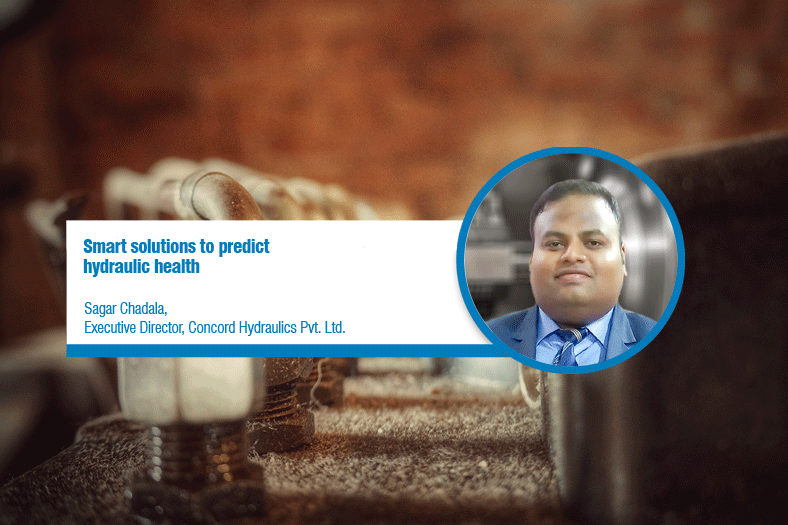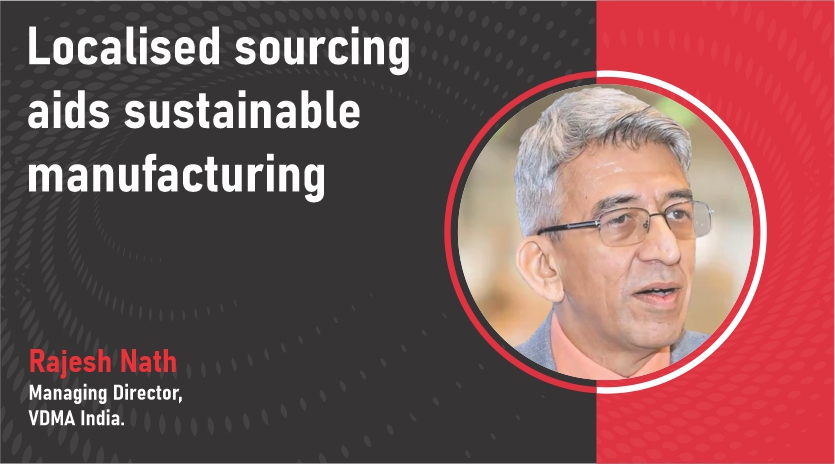Smart solutions to predict hydraulic health
January 9, 2020 2:47 pm
Presently, a hydraulic system’s health and its continuous and smooth running is a completely predictive term.
In a discussion, Sagar Chadala, Executive Director, Concord Hydraulics Pvt. Ltd. explains how changed is the hydraulic system as of now health and its continuous and smooth running has become predictive term, and not like the past when the hydraulic system is considered to be leakage prone, unsafe and non-productive operating system, with certainty of failure at any time and moment.
What smart industry solutions are being provided in hydraulics and pneumatics?
Hydraulics and/or pneumatics are currently serving the industry as a backbone in the contemplation, design and application for the most intricate and complex motion and power control problems, which many a times are found difficult to be handled by pure mechanical or electrical systems alone.
Hydraulic/pneumatic systems are broadly divided into industrial, mobile, defence, marine, and aviation segments, and the product selection for each is based on its environmental safety norms, noise and vibration control, contamination control, risks and hazards, and the technical capability of individual products that apply to the making of the systems for each of the above segments.
- Thus, the smart solutions provided currently for industrial applications alone in hydraulic/pneumatic systems are broadly based as follows:
- The optimisation of control to provide for the correct application need
Product selection for ease of maintenance, longer life span of equipment and bigger intervals in maintenance schedules - Lightweight, compact, highly integrated but sturdy designs for systemised power units and control stands
- Ergonomical design of system based on manufacturer and acceptable quality norms, with/without data acquisition system embedded for diagnostic approach
- System design even in its conceptual stage based on low contamination generation techniques
- Industrial Internet of Things and integration with digital technology to give proper diagnosable and controllable system with online and offline maintenance support, with periodic and predictive maintenance as a main driving element to give zero downtime in productivity.
What kind of testing and analysis is done for hydraulic fluid? How is the state of a hydraulic fluid monitored?
Hydraulic systems currently in the industry use many types of system fluids, including mineral oils, phosphate esters, water glycols, and even plain tap water. Hydraulic systems can be made extremely reliable and highly productive if the fluid used to operate it is kept in the best of its health and continuously monitored to stay that way throughout the life of the equipment.
The product’s capabilities are enhanced by making it operate at elevated pressures like 350 bar instead of 210 bar as was 15 years ago. This pressure capability rise will further increase to, say, 400 bar in the near future, by having appropriate materials available now in the industry to make hydraulic products.
This high-pressure capability calls for compact and lighter design and necessarily tighter tolerances in manufacturing to give better result and longevity of product under continuous running at elevated pressures. Surface clearances like 3-5 microns are now becoming common in many products, which are brought in the market with higher capabilities. To cater for such fine tolerance zone and without damage to the product’s structured design, the oil used must be correctly selected, monitored and maintained with perfect contamination control.
Oil is tested by a manufacturer in many ways, namely for its viscosity, operable temperature range, solid, liquid and gaseous contamination available prior to dispatch, and anti-oxidation and anti-foaming properties.
But when it comes to supporting the hydraulic system in its end user’s equipment, the only way to control its health is to use a proper filter at proper location, of proper size, proper type and proper micronic filtration capability.
- To monitor the health of oil, following methods are used:
- The colour of oil is direct visual information to user to indicate contamination. Darker the oil colour, higher is the contamination.
- The viscosity of oil can be checked by sending the sample to the manufacturer or laboratory.
- Amount of solid contamination available in the oil can be easily monitored by using particle counter machines or patch kit sampling devices which are available in many designs or can be custom-built or tailor-made for specific application.
Particle counter machines are the best solution to check, continuously monitor and maintain proper oil condition to run the system for a long time without failure. Contamination to even 3 micron size can be detected in these machines and the values of actual solid contamination numbers obtained in 5 micron/10 micron/15 micron size from the oil can be used to produce its ISO grade which is internationally accepted and implemented by all users, designers, manufacturers, and consultants. Comparing results of oil samples taken and checked for its ISO grade from time to time can maintain the system health to its best, as it maintains the oil condition to the required tolerance limit and grade.
Around 90 percent of failures in hydraulic systems are attributed to contaminated oil, and nowadays the industry has fine micronic graded, high-pressure and advanced filters to safeguard oil, reduce downtime and maintenance costs, and get higher productivity from machines.
Proper sampling of oil from various locations in the oil hydraulic system can give a proper health record of the oil in order to ensure well-maintained overall hydraulic system health.
Which automation technologies are in place to tackle common service and maintenance tasks?
Presently, a hydraulic system’s health and its continuous and smooth running is a completely predictive term, and not like in the past when the hydraulic system was considered to be a leakage-prone, unsafe and non-productive operating system, with certainty of failure at any time.
The same stands true even today if some basic conditions of operation are not monitored and maintained. They are as follows:
- Common servicing and maintenance task in hydraulics is mainly related to the cleanliness of the system fluid — oil. Oil is kept clean in hydraulic systems by using proper filters. Once the filters are selected and properly placed in the system, the next task is to check their health periodically so that they work diligently to keep the oil clean.
- Automated particle counter system or online oil monitoring system is an answer to it. This system can be hooked to any hydraulic system and programmed to give periodic oil sampling tests and diagnostic records to see how the oil is being contaminated and also kept clean. This reduces cost of maintenance drastically.
- Other automation technologies employed are to monitor the oil level in the tank, and on reaching the minimum acceptable set level for minimum oil in the tank, the alarm is sent to operator as well as the control PLC or system to stop or trip the system to avoid further damages to important hydraulic products like pumps, etc.
- Another technology employed is to monitor and take proper care of the oil temperature. Systems are equipped with water or air in oil cooling circuits or are provided later once the rise in temperature is established and data record reveals that oil cooling is necessary. Many oil hydraulic systems have inbuilt programmed temperature signalling to start or stop water or air supply for cooling oil.
- Today, Internet of Things is coming in a big way with the digital technology platform to enhance the predictive and progressive maintenance mode for online monitoring of system health to operate with zero downtime. This calls for new products, sensors, bus systems to connect the entire product for data logging techniques, and using appropriate data for maintaining and servicing of system.
- Many software-driven systems are in the market to pick up data from the hydraulic system like oil level, temperature, pressure, noise, etc. which can be converted into electrical values and are transmitted to the mobile app to reproduce the result in exact physical values of the entity measured to give the person or service station, who may be away from the system, the exact nature of working parameters on his desktop or hand-held mobile device.
- Noise level in the hydraulic system is also very annoying, and safe and silent systems are always welcome to enhance the environmental condition around the system where people are working. Monitoring noise from 1 meter distance and recording the noise level of pump is also considered important to know its health and judge longevity of major maintenance breakdowns. The pump is the heart of any system to safeguard its working life; this small but important monitoring is an essential requirement and can be embedded into automation system for periodic maintenance.
Cookie Consent
We use cookies to personalize your experience. By continuing to visit this website you agree to our Terms & Conditions, Privacy Policy and Cookie Policy.

















 English
English Hindi
Hindi